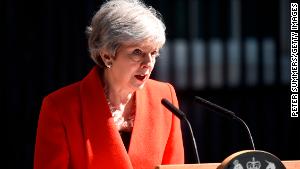Updated 1057 GMT (1857 HKT) November 16, 2018

But it's far from a done deal. The full 585-page draft withdrawal agreement is long and complex and contains several highly contentious clauses.
With both supporters and opponents of Brexit likely to provide strong opposition to the deal, albeit for very different reasons, it remains unclear whether it will get approval from the UK Parliament.
What, then, are the major sticking points? And how might they be resolved?
You can read the full draft document here. But to help save you time, we've summarized some of the key points below.
Transition period
Britain will formally exit the EU on Friday, March 29, 2019, at which point it will cease to be involved at any level in EU decision-making.
However, under the draft agreement, the UK will stay inside the bloc's single market and remain subject to EU laws and regulations until the end of December 2020 while the two sides attempt to iron out a new trade relationship.
During this period, all existing EU "regulatory, budgetary, supervisory, judiciary and enforcement instruments and structures" will continue to apply within the UK, including rulings made in the Court of Justice of the EU.
In effect, the transition period provides the two parties with additional time in which to continue negotiations. If the extra 21 months prove insufficient -- and critics suggest they almost certainly will -- the transition period can be extended, by joint agreement before July 1, 2020, for an unspecified period of time.
Irish border and customs union
There will be no hard border between Northern Ireland, which is part of the UK, and EU member the Republic of Ireland, at least in the short term.
In the event of the transition period being extended beyond 2020, the draft deal commits both parties to a "backstop" solution, consisting of a "single customs territory between the (European) Union and the United Kingdom."
That customs union would remove all tariffs, checks on rules of origin and quotas, and would cover all goods except fishery products. "To this end, the United Kingdom will harmonize the commercial policy applicable to its customs territory with the common commercial policy of the Union," the agreement says.
During this period, the UK will adopt what the document terms "level playing field" conditions, ensuring that UK businesses are unable to undercut EU competitors, effectively removing the possibility of the UK transforming into a Singapore-style low-tax business haven, as envisioned by some pro-Brexit supporters.
Under these conditions, the UK will be required to agree to a number of "non-regression clauses," preventing it from introducing new, lower standards on key environmental, labor and social regulations, including such things as health and safety policy and working hours.
While part of the customs union, the UK will be bound by all EU international trade agreements. Controversially, this would mean that countries outside the EU, such as the United States and China, would have access to the UK market under conditions set out in the EU's trade agreements.
Furthermore, once the backstop has come into place, it can only be removed through the agreement of both parties, essentially preventing the UK from exiting the customs union without the approval of the EU.
Financial markets
The City of London has played an outsize role throughout Brexit negotiations, with both the pro- and anti-Brexit camps attempting to leverage the capital's status as the world's leading financial center.
That status could now be at risk. While many of London's financial institutions have been preparing for a no-deal Brexit, the new agreement is by no means advantageous.
Throughout the entire 580-page document, a mere three paragraphs totaling fewer than 300 words are devoted to the UK's financial sector.
Under the draft agreement, "entities established in the United Kingdom shall be treated as entities located outside the Union." In practice, this is likely to result in London's financial center being granted a level of EU market access similar to that granted to US and Japanese firms, under an arrangement known as "equivalence," potentially jeopardizing London's attractiveness to international financial companies.
Freedom of movement
The draft document provides protections for the more than three million EU citizens in the UK, and over one million UK nationals in EU countries to continue to live, work or study as they currently do.
Crucially, "no exit visa, entry visa or equivalent formality shall be required of holders of a valid document issued" for EU and UK nationals when crossing national boarders within the bloc.
Freedom of movement will be maintained until a final agreement is reached, and EU citizens and UK nationals arriving in the host state during the transition period will enjoy the same rights as those who arrived in the host state before March 30, 2019.
UK divorce bill
According to an EU summary document, the "agreement is not about the amount of the UK's financial obligation, but about the methodology for calculating it."
Under this rationale, the UK will honor all existing joint commitments to EU programs as outlined in the EU budget until 2020, "including outstanding commitments at the end of 2020 and liabilities which are not matched by assets."
Previously this has been estimated at about 50 billion pounds ($64.8 billion).
Video of Theresa May's speech on the Agreement is on: